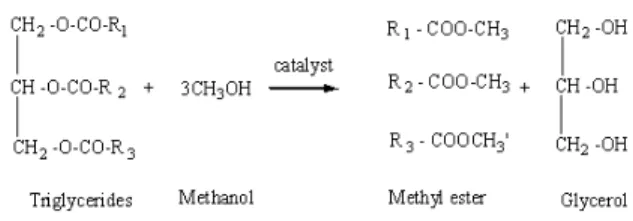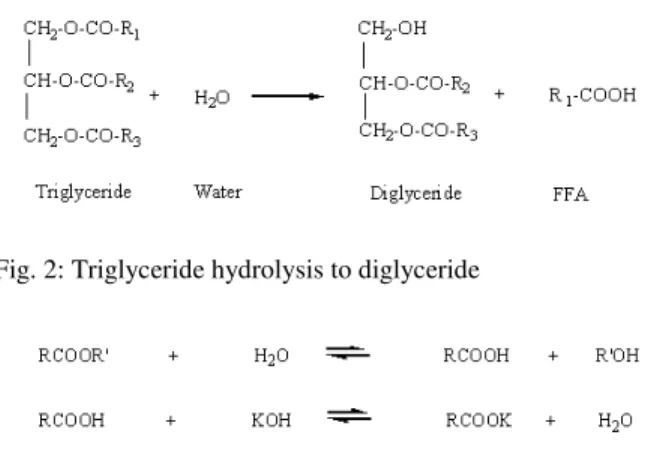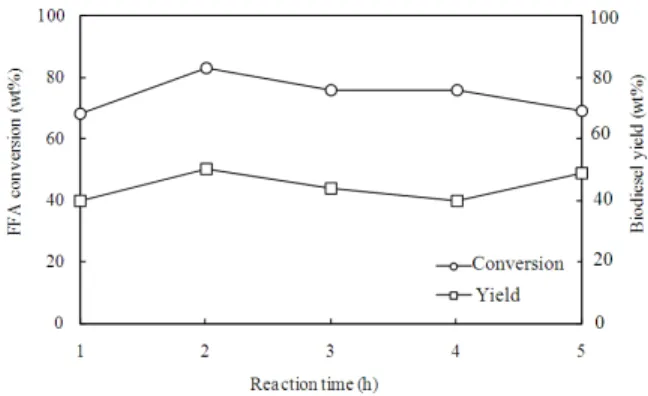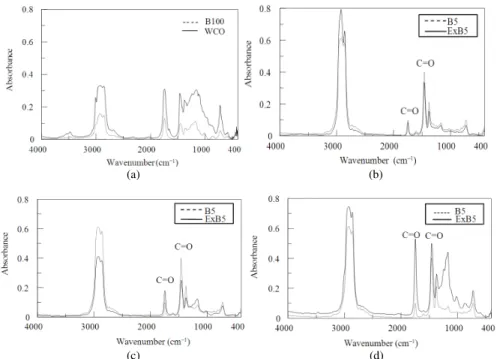ISSN 1546-9239
© 2010 Science Publications
Corresponding Author: Cholada Komintarachat, Department of Fundamental Science and Physical Education, Faculty of Resources and Environment, Kasetsart University, Chonburi 20230, Thailand Tel: +66(0) 38 354587 Fax: +66(0) 38 354587
Methanol-Based Transesterification Optimization of Waste
Used Cooking Oil over Potassium Hydroxide Catalyst
1
Cholada Komintarachat and
2Sathaporn Chuepeng
1
Department of Fundamental Science and Physical Education,
Faculty of Resources and Environment,
2
Department of Mechanical Engineering, Faculty of Engineering at Si Racha,
Kasetsart University, Chonburi 20230, Thailand
Abstract: Problem statement: Waste used Cooking Oil (WCO) harmfully affected to environment and
human’s health can be a feedstock for producing biodiesel. Approach: The conversion of Fatty Acid and Free Fatty Acid (FFA) of WCO with 15.0% w/w FFA content to biodiesel was studied through transesterification reactions.This work investigated the effects of alcohol and catalyst quantity, reaction time and temperature on the FFA conversion and biodiesel production and also determines the optimum condition.
Results: The optimum use of 5% w/w potassium hydroxide (KOH) catalyst at 70°C for 2 h yielded 88.20%
FFA conversion and 50% biodiesel recovery of WCO. For the reaction rate analysis, based on Arrhenius equation, the activation energy of 47.07 kJ.mo1−1 and the pre-exponential factor of 7.58×1010 min−1 were obtained using pseudo first-order model. In addition, the produced biodiesel was blended with diesel in the volumetric proportions of 5:95 (ExB5), 20:80 (ExB20) and 50:50 (ExB50) and characterized by FT-IR, in order to compare to biodiesel blend sold in local gas station (B5). It was observed that the ExB5 has exhibited the same functional group as of the B5. Conclusion: The produced biodiesel may be used in diesel engines if other properties are tested for compatibility. This provides one more choice for alternative energy and commercialization.
Key words: Wasted used cooking oils,free fatty acid, transesterification, esterification, biodiesel
INTRODUCTION
Waste used Cooking Oil (WCO) is a residue from a variety of sources, e.g., restaurants, food industrial or domestics, which not only harms human’s health but also causes environmental problems. However, WCO can be used as a raw material for biodiesel production. By this manner, the production of biodiesel from WCO to partially substitute petroleum diesel is an alternative way for environment protection and energy security.
General vegetable oils or animal fats comprise the main constituent of Triglycerides (TGs) with lower density compared to water and may be solid or liquid at normal room temperature. TGs are esters of saturated and unsaturated monocarboxylic acids with the trihydric alcohol glyceride. These esters are collectively called triglycerides, which can react with alcohol in a presence of catalyst, widely known as transesterification process (Balat and Balat, 2010). Figure 1 shows that a triglyceride reacts with short chain alcohols such as methanol and ethanol in the presence of a catalyst to produce Fatty Acid Methyl Esters (FAMEs) or Fatty
Acid Ethyl Esters (FAEEs) and glycerol (Encinar et al., 2007) where R1, R2 R3 represent long chain of fatty acid.
Generally, there are five main types of chains in vegetable oils and animal oils, i.e., palmitic, stearic, oleic, linoleic and linolenic (Chhetri et al., 2008). When the triglyceride is decomposed, stepwise to diglyceride, monoglyceride and ultimately to glycerol, one mole of fatty acid ester is liberated in each step. Methanol is preferably used for the transesterification due to its low cost and advantages in physical and chemical properties, i.e., polarity and small molecule (Sanli and Canakci, 2008). In addition, it can easily react with triglycerides and catalyst can be dissolved faster than other alcohols.
1074 Fig. 2: Triglyceride hydrolysis to diglyceride
Fig. 3: Saponification of free fatty acid alkyl ester
Unlike new oil, WCO may contain small amounts of water and Free Fatty Acids (FFAs). FFAs are generated through the hydrolysis of triglycerides during the high temperature cooking process. The FFA content is directly related to the acid number of WCO that can become a serious issue when feedstocks with high FFA are used to produce biodiesel (Chongkhong et al., 2007). FFA values vary in various sources of WCOs obtained under different cooking, collection and storage conditions. Water, either originated from the oils and fats or formed during the saponification reaction, retards the transesterification through the hydrolysis reaction. It can hydrolyze the triglycerides to diglycerides and further form FFA. A typical hydrolysis reaction is shown in Fig. 2. For alkali-catalyzed transesterification, the alkali catalyst will react with the FFA to form soap (Encinar et al.,2007). Figure 3 shows the saponification reaction of the catalyst (potassium hydroxide) and the FFA, forming soap and water. This reaction is undesirable as the soap lowers the yield of biodiesel and inhibits the separation of esters from the glycerol (Gerpen, 2005). In addition, it binds with the catalyst, meaning that more catalyst will be needed and the process will, therefore, involve a higher cost.
The main aim of this research work is to study the transesterification of TGs of WCO and the esterification of FFA to produce biodiesel. The conversion of FFA to biodiesel will be determined, depending up on parameters affected the biodiesel production process such as catalyst concentration, methanol-to-WCO ratio, temperature and reaction time. The optimal process operating conditions for transesterification reaction will then be identified. Ultimately, the subsequent WCO biodiesel as a blended fuel with diesel will be compared to biodiesel blends sold in the local gas station.
MATERIALS AND METHODS
Reagents and materials: The WCO used throughout
the test was obtained from the canteen of Kasetsart University Siracha Campus and was filtered to remove suspended particles before use. The WCO’s acid number was measured by titration (Marchetti et al., 2007) and the FFA content of 15.0% w/w was obtained. All other chemical reagents were of analytical grade.
Equipment: The experiment was conducted using
round bottom flask as a reactor. The reaction flask was placed on a hot plate equipped with a magnetic stirrer that has a maximum heating capacity of 600°C and stirring speed of 2000 rpm. A thermometer was fixed by the use of a stand and immersed into the flask for verifying and controlling the temperature of the hot plate.
Transesterification: The 50 g WCO used for all the
experiments were heated up to a desired temperature on the hot plate. After the oil reached the desired temperature, the prepared potassium hydroxide– methanol solution was poured into the flask; this moment was as the reaction starting time. When the reaction reached the preset reaction time, the heating and stirring were then stopped. All the reaction products were allowed to settle overnight as to enhance separation. Two distinct liquid phases were formed during separation, in such a manner that the crude ester phase presented at the top and the glycerol phase at the bottom. The glycerol phase was removed while the crude WCO methyl ester layer was washed with warm water at 50°C for three times. The WCO methyl ester was then soaked with deionized water at room temperature until the water became neutral, finally dried with anhydrous Na2SO4 (Komintarachat and Chuepeng,
2009) and filtered in this phase. The resultant WCO biodiesel were subjected to Gas Chromatography (GC) for identification of product yield and titration for acid value and FFA conversion, according to Eq. 1 and 2, respectively (Park et al.,2008):
56×V×F×M Acid value =
g (1)
initial final
initial (FFA - FFA ) FFA conversion (%)= ×100
FFA (2)
Where:
56 = Molecular weight of potassium hydroxide (KOH)
V = The volumetric KOH standard solution in the
F = Concentration coefficient of the KOH standard solution
g = Sample weight (g)
Gas chromatography: The quantitative analysis of the
WCO biodiesel was carried out using a temperature programmed Varian CP-3800 gas chromatograph. One microliter of the clean treatment upper oil layer was dissolved in 10 mL n-heptane and 1 L internal standard solution (heptadecanoic acid methyl ester, conforming to EN 14103 standard) for GC analysis. On each run, the 1 L sample was injected into the GC at the temperature of 140°C and held for 5 min. The GC’s oven was heated at 10°C.min−1 rate to 250°C. Helium was used as a carrier gas, operated at 10 bar pressure and 20 mL.min−1 flow rate. The injector and the Flame Ionization Detector (FID) were set up to the operating temperature of 250°C. Calibration standards were prepared from a known concentration of methyl esters solution. The standards were used to plot a calibration curve in determining the methyl esters (Madras et al.,2004).
Fourier Transform Infrared spectroscopy (FTIR)
determination: The WCO biodiesel content in a
blended fuel was determined by infrared spectroscopy. Initially, the measurement of absorbance was performed using 16 scans in the range of 4000 cm−1 down to 400 cm−1 with 4 cm−1 resolution. The WCO biodiesel-diesel mixtures were tested in the volumetric proportions of 50:50 (ExB50), 20:80 (ExB20) and 5:95 (ExB5). All absorbance measurements were performed with a Fourier Transform Infrared Spectrometer (FTIR) JASCO model 4100.
RESULTS
Effects of methanol content: Methanol is an important
reactant used in the process of esterification of FFA and transesterification of fatty acids; it merges with triglycerides and FFA to form methyl esters. The effect of methanol-to-WCO weight ratio on the conversion of FFA and biodiesel obtained is shown in Fig. 4, at 5.0 wt% KOH, 70°C reaction temperature and 2 h reaction time.
Effects of catalyst amount: The amount of catalyst can
affect the transesterification (Santos et al., 2009), resulting in different FFA conversion and biodiesel yield as shown in Fig. 5.
Effects of reaction time: The effects of reaction time
were investigated using the optimal parameters obtained from the investigation of methanol and catalyst amount effects. The time was varied from one to five hours as the results are shown in Fig. 6.
Fig. 4: Effect of methanol/WCO weight ratio on the FFA conversion and biodiesel yield, 5.0 wt% KOH, 70°C temperature, 2 h reaction time
Fig. 5: Effect of KOH/WCO weight ratio on the FFA conversion and biodiesel yield, 60 wt% methanol, 70°C temperature, 2 h reaction time
Fig. 6: Effect of reaction time on the FFA conversion and biodiesel yield, 60 wt% methanol, 5.0 wt% KOH, 70°C temperature
Effects of reaction temperature: In studying the effect
1076 catalyst and methanol/WCO weight ratio, while reaction time was maintained at 2 h. The reaction temperature affected on the biodiesel yield were varied from 50-100°C in the condensed flask to avoid methanol phase changed (methanol boiling point at 64°C). Figure 8 shows the optimum point for biodiesel yield and FFA conversion at 70°C reaction temperature.
WCO biodiesel and commercial biodiesel
comparison: Figure 9a shows the Infrared (IR)
spectra of WCO before and after treatment (B100). The IR-spectra of WCO biodiesel-diesel blends and commercial Biodiesel (B5) in Fig. 9b-d shows an absorption peak measurement (Aliske et al.,2007).
DISCUSSION
It has seen in Fig. 4 that the use of low methanol amount of 0.5 wt% led to the FFA conversion become incompleted and resulted in a low yield of biodiesel. The yield increased and reached optimum reactions at a methanol amount of 60 wt%. At higher methanol amount, the FFA conversion increased but the yield decreased. This is due to the transesterification was reversible (Shu et al., 2010) as the additional methanol accelerates considerably an adjustment of the new equilibrium. A high amount of methanol interferes the separation of glycerol due to an increase in solubility (Maceiras et al.,2009) while the glycerol remaining in the solution drives the reaction equilibrium back, resulting in the lower yield of biodiesel (Kotwal et al.,2009).
Fig. 7: Effect of reaction temperature on the FFA conversion and biodiesel yield, 60 wt% methanol, 5.0 wt% KOH, 2 h reaction time
Fig. 8: Arrhenius plot for transesterification rate constant of WCO methyl ester with 60 wt% methanol, 5.0 wt% KOH, 2 h reaction time
(a) (b)
(c) (d)
In Fig. 5, at the KOH/WCO weight ratios of 1 and 3, the WCO incompletely converted to biodiesel. In this experiment, the maximum conversion of FFA and biodiesel yield occurred at KOH/WCO weight ratio of 5. When the amount of KOH/WCO weight ratio exceeded 5 wt%, the conversion of FFA decreased. Although higher amounts of KOH were added, the biodiesel yield decreased as the reverse reaction (Ataya et al., 2007). In addition, more soap was observed, as the excess KOH favored the saponification reaction. This was observed at the catalyst concentration of 7.0 wt%.
It was observed from Fig. 6 that at 1 h reaction time, the FFA conversion and biodiesel yield seemed not to reach their completion. This may be due to the esterification reactions are faster than transesterification reactions (Leung et al.,2010). However, biodiesel yield increased as the time was lengthened to 2 h. With the longer reaction period of up to 3 h, the decreased yield and more soap formation were observed during washing. This occurred as a result of the hydrolysis of esters which tends to cause more fatty acids to form soap (Pena et al., 2009). The optimum yield was observed at the reaction time of 2 h.
In Fig. 7, at 100°C, the yield slightly inclined, owing to high temperatures favoring the side reaction of transesterification, i.e., hydrolysis and saponification (Pena et al., 2009). The saponification was also observed during washing with warm deionized water. It has to be noted that lower temperatures may require longer reaction time for the completion of the reaction, as found by the slow forming of the phase change. However, at higher temperature, it may require a shorter time to complete due to the fast forming of phase change.
In order to quantify the temperature effect on the reaction and evaluate the apparent activated energy of the reaction, the experimental results were further analyzed in terms of the kinetics of WCO methyl esters. As the operating parameters for the reaction were fixed at 60 wt% methanol, 5.0 wt% KOH and 2 h reaction time, the reaction data were fitted to a first-order model in the form of Arrhenius rate equation (Jain and Sharma, 2010) as:
a
E
-RT
k =Α×e (3)
Where:
A = Pre-exponential factor Ea = Apparent activation energy
R = Gas constant
T = Reaction temperature in Kelvin
The plot of ln k versus 1/T in Fig. 8 with the slope of activation energy confirms the pseudo first-order reaction kinetics.
The apparent activation energy in the reaction temperature range from 323-373 K was 47.07 kJ.mol−1 and the corresponding pre-exponential factor was 7.58×1010 min−1. The obtained activation energy was comparable to that in the published work which used two step H2SO4 and NaOH catalysts (Ea = 49.3
kJ.mol−1) (Jain and Sharma, 2010) and calcium and lanthanum oxides catalyst (Ea = 87.8 kJ.mol−1)
(Yan et al., 2009) transesterification of vegetable oils. The Ea from this work represents an energy required for
the transesterification of WCO that is favorable for biodiesel production from high FFA oils.
It was observed from Fig. 9b-d that WCO biodiesel for all proportions and B5 showed many overlap peaks. The prominent peaks from 1850-1450 cm−1 wave number correspond to carbonyl group of ester (C=O) absorption (Nabi et al., 2006) The ester absorbance shown in high intensity for all the WCO biodiesel blends and the ExB5 seem quite perfect in overlapping to the commercial B5 over the range of 4000-400 cm−1 wave number.
CONCLUSION
The transesterification of WCO over KOH catalyst to biodiesel was studied and presented. The operating parameters such as methanol content, catalyst amount, reaction time and reaction temperature were found to affect the reaction. The optimum FFA conversion and biodiesel yield were obtained at 60 wt% methanol/WCO weight ratio, 5 wt% KOH, 2 h reaction time and 70°C reaction temperature. At this condition, the reaction gave comparatively low activation energy. The infrared absorbance measurement to determine the produced WCO biodiesel performance and its blends in the volumetric WCO biodiesel: diesel proportions of 5:95 (ExB5), 20:80 (ExB20) and 50:50 (ExB50) were determined by FTIR. The spectra obtained indicated peaks of WCO biodiesels and B5 overlapped the carbonyl (C=O) absorption peak. The results of IR spectra make this proportion WCO biodiesel compatible to the B5 biodiesel blends sold in Thailand. This can be considered as an alternative environmentally-friendly fuel for diesel engines.
ACKNOWLEDGEMENT
1078 and Environment for the provision of laboratory equipments. Senior project students Ms. Doungchai Moolsorn and Ms. Nuttaramunya Chantrapaprakul are acknowledged for their experimental assistance.
REFERENCES
Aliske, M.A., G.F. Zagonel, B.J. Costa, W. Veiga and C.K. Saul, 2007. Measurement of biodiesel concentration in a diesel oil mixture. Fuel, 86: 1461-1464. DOI: 10.1016/j.fuel.2006.11.008 Ataya, F., M.A. Dube and M. Ternan, 2007.
Acid-catalyzed transesterification of canola oil to biodiesel under single-and two-phase reaction conditions. Energy Fuels, 21: 2450-2459. DOI: 10.1021/ef0701440
Balat, M. and H. Balat, 2010. Progress in biodiesel processing. Applied Energy, 87: 1815-1835. DOI: 10.1016/j.apenergy.2010.01.012
Chhetri, A.B., K.C. Watts and M.R. Islam, 2008. Waste cooking oil as an alternate feedstock for biodiesel production. Energies, 1: 3-18. DOI: 10.3390/en1010003
Chongkhong, S., C. Tongurai, P. Chetpattananondh and C. Bunyakan, 2007. Biodiesel production by esterification of palm fatty acid distillate. Biomass
Bioenergy, 31: 563-568. DOI:
10.1016/j.biombioe.2007.03.001
Encinar, J.M., J.F. Gonzalez and A. Rodriguez-Reinares, 2007. Ethanolysis of used frying oil. Biodiesel preparation and characterization. Fuel Process.
Technol., 88: 513-522. DOI:
10.1016/j.fuproc.2007.01.002
Gerpen, J.V., 2005. Biodiesel processing and production. J. Fuel Process. Technol., 86: 1097-1107. DOI: 10.1016/j.fuproc.2004.11.005
Jain, S. and M.P. Sharma, 2010. Kinetics of acid base catalyzed transesterification of Jatropha curcas oil. Bioresour. Technol., 101: 7701-7706. DOI: 10.1016/j.biortech.2010.05.034
Komintarachat, C. and S. Chuepeng, 2009. Solid acid catalyst for biodiesel production from waste used cooking oils. Ind. Eng. Chem. Res., 48: 9350-9353. DOI: 10.1021/ie901175d
Kotwal, M.S., P.S. Niphadkar, S.S. Deshpande, V.V. Bokade and P.N. Joshi, 2009. Transesterification of sunflower oil catalyzed by flyash-based solid catalysts. Fuel, 88: 1773-1778. DOI: 10.1016/j.fuel.2009.04.004
Leung, D.Y.C., X. Wu and M.K.H. Leung, 2010. A review on biodiesel production using catalyzed transesterification. Applied Energy, 87: 1083-1095. DOI: 10.1016/j.apenergy.2009.10.006
Maceiras, R., M. Vega, C. Costa, P. Ramos and M.C. Marquez, 2009. Effect of methanol content on enzymatic production of biodiesel from waste frying oil. Fuel, 88: 2130-2134. DOI: 10.1016/j.fuel.2009.05.007
Madras, G., C. Kolluru and R. Kumar, 2004. Synthesis of biodiesel in supercritical fluids. Fuel, 83: 2029-2033. DOI: 10.1016/j.fuel.2004.03.014 Marchetti, J.M., V.U. Miguel and A.F. Errazu, 2007.
Heterogeneous esterification of oil with high amount of free fatty acids. Fuel, 86: 906-910. DOI: 10.1016/j.fuel.2006.09.006
Nabi, M.N., M.S. Akhter and M.M.Z. Shahadat, 2006. Improvement of engine emissions with conventional diesel fuel and diesel-biodiesel blends. Bioresour. Technol., 97: 372-337. DOI: 10.1016/j.biortech.2005.03.013
Park, Y.M., D.W. Lee, D.K. Kim, J.S. Lee and K.Y. Lee, 2008. The heterogeneous catalyst system for the continuous conversion of free fatty acids in used vegetable oils for the production of biodiesel. Catal. Today, 131: 238-243. DOI: 10.1016/j.cattod.2007.10.052
Pena, R., R. Romero, S.L. Martinez, M.J. Ramos, A. Martinez et al., 2009. Transesterification of castor oil: Effect of catalyst and co-solvent. Ind. Eng. Chem. Res., 48: 1186-1189. DOI: 10.1021/ie8005929 Sanli, H. and M. Canakci, 2008. Effects of different
alcohol and catalyst usage on biodiesel production from different vegetable oils. Energy Fuels, 22: 2713-2719. DOI: 10.1021/ef700720w
Santos, F.F.P., L.J.B.L. Matos, S. Rodrigues and F.A.N. Fernandes, 2009. Optimization of the production of methyl esters from soybean waste oil applying ultrasound technology. Energy Fuels, 23: 4116-4120. DOI: 10.1021/ef900290r
Shu, Q., J. Gao, Z. Nawaz, Y. Liao and D. Wang et al., 2010. Synthesis of biodiesel from waste vegetable oil with large amounts of free fatty acids using a carbon-based solid acid catalyst. Applied Energy,87: 2589-2596. DOI: 10.1016/j.apenergy.2010.03.024



